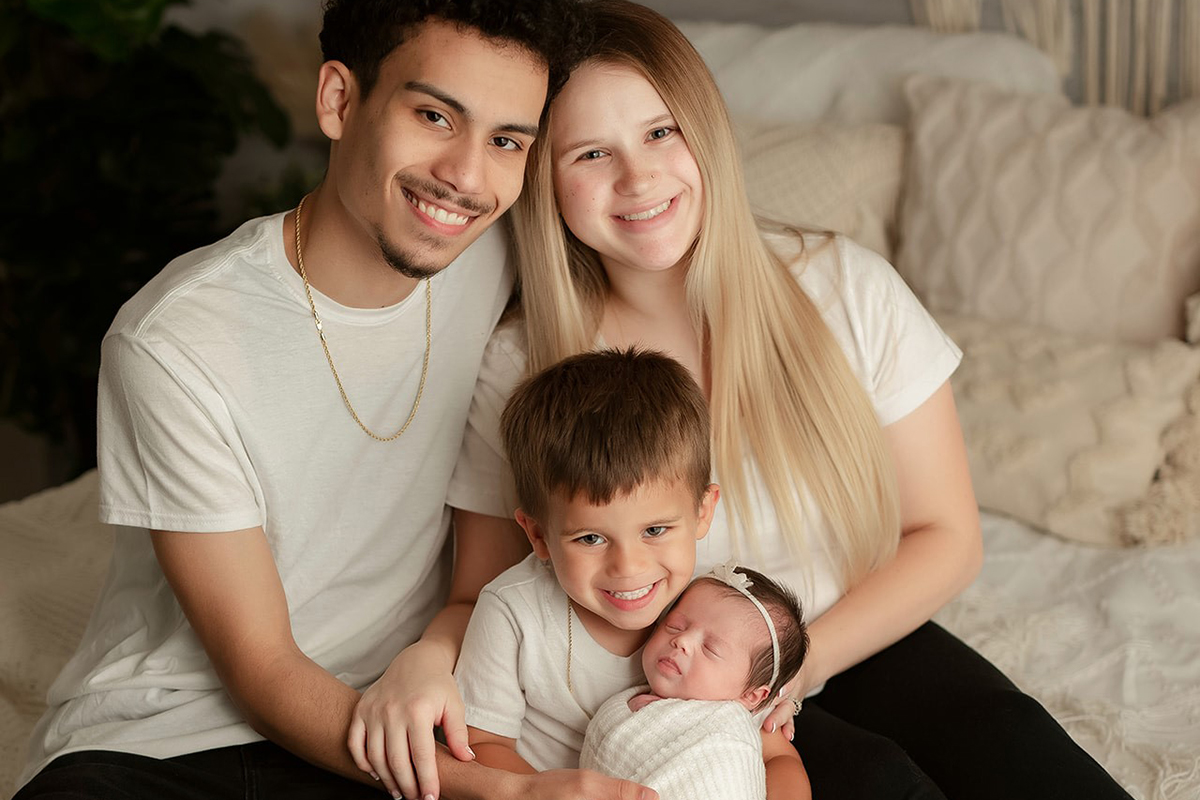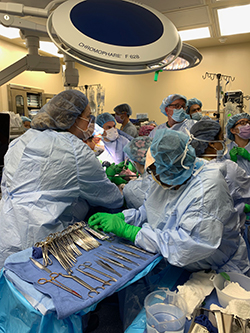-
Services
Featured Specialties
-
Locations
Location Type
-
Patients & Visitors
Published August 16, 2023

Summer Rodriguez, 22, from Naugatuck, CT, was planning her baby shower when shocking news changed the trajectory of her pregnancy from textbook delivery to a team of over 40 specialists performing a life-saving procedure for her baby girl ... mid-birth.
The first six months of Summer’s pregnancy were typical. Of course, she had aches and pains while working full time as a daycare teacher and caring for her three-year-old son, but around 26 weeks something felt different.
“I noticed I was carrying much bigger than my previous pregnancy and then the early contractions started,” said Summer.
Summer brought her concerns to her obstetrical practice and from there was sent to Bridgeport Hospital. Doctors confirmed she had excess amniotic fluid, gave her medications to stop the contractions and transferred her to Yale New Haven Children’s Hospital for more scans.
It was here where Ozan Bahtiyar, MD, saw a mass on the baby’s neck. Dr. Bahtiyar is co-director of Yale New Haven Children's Hospital Fetal Care Center, a professor of Obstetrics, Gynecology & Reproductive Sciences at Yale University School of Medicine, and an expert in diagnosing and treating complex abnormalities in babies.

“When we see something like a mass on a scan our first thought is how is this mass going to impact this baby’s transition to post-natal life– will this baby be able to breathe when she is born?” said Dr. Bahtiyar.
At Yale New Haven Children’s Hospital, patients with abnormalities on their scans are followed by the Fetal Care Center, where a village of specialists assemble to review images and raise concerns and potential solutions from their unique lens.
“We had regular meetings and the whole team agreed that an EXIT procedure was the best path forward for Summer and her baby,” said Dr. Bahtiyar.
Ex utero intrapartum treatment, also called EXIT, is a surgical procedure used to deliver babies with airway compression. The baby is delivered up to the shoulders and, while the placenta continues to supply the baby with oxygen, surgeons and other specialists clear and stabilize the airway before fully delivering the baby. By operating while the baby is still supported by the mother, the baby avoids the risk of being born unable to breathe.
“I was really emotional after learning about the neck mass,” said Summer. “A million questions were going through my head and Diana Giasullo, RN, fetal therapy nurse coordinator, made sure I was able to get them all answered. My husband had to work during many of my appointments, so Diana was an essential support for me.”
A multidisciplinary team including physicians from Neonatology and Pediatric ENT simulated the procedure several times to prepare. With so many specialists in a small space, the operation needed to work like an orchestrated symphony – each person coming and going exactly as needed.
“Summer is exceptional,” said Diana. “When faced with stress and the unknown, she reached out with questions. She requested to be with her baby immediately upon waking and not to be intubated when her family saw her. We accommodated every request to make her first experiences with her new baby as special as possible.”
At 34 weeks and 6 days Summer met with Dr. Bahtiyar to check her fluid levels. During this appointment, it was decided that the risk of waiting to deliver at 37 weeks, as planned, was too great and Summer had to deliver that day.
“I compartmentalized my emotions so I could absorb everything I was learning,” said Summer. “It was reassuring to see everybody’s confidence and hearing that they had a plan and several backup plans for anything that could go wrong.”
The team was ready within an hour of the news.
“This procedure only works because our team is committed to the best outcome for both lives in our hands, no matter when it has to happen.” said Dr. Bahtiyar.
Summer was placed under very deep anesthesia which allows the uterus to relax and placenta to remain attached. A cesarean section was performed under highly controlled conditions to ensure there was no active bleeding.
The baby was delivered up to her shoulders and turned on her back for best access to her airway.
“At this point in the procedure the baby is half fetus, half newborn – but she cannot know she is in the world,” said Dr. Bahtiyar. “So we keep her conditions womb-like … we can’t even put a heart monitor on her so I tap my fingers to her heart beat to keep track.”
A tube was placed through the baby’s mouth and into her airway so she could be placed on a ventilator to assist with breathing. The team used about 15 of their 30-minute deadline to perform the procedure before Elianna was officially born. Following recovery, Summer was taken to the NICU to meet her daughter for the first time. She braced for the worst but hoped for the best.
Baby Elianna’s mass looked like a ball inside her neck, causing the other side of her neck to jut out. After several days in the NICU, the team operated again to successfully remove the mass, which was diagnosed as a teratoma, a benign formation that has low risk of returning. Elianna stayed in the NICU for a two more weeks where she received physical therapy to help her recover.
“We saw her personality emerge in those early days,” said Summer. “She would use all her little strength to move her monitor and nurses would rush to her side only to see that she was perfectly fine!”
Elianna continues to receive supportive services to ensure her development stays on track. Looking at Elianna and Summer, no one would know the journey they have been on. Summer maintains that building trust with her clinical team was one of the best investments of her time throughout this process.
“I couldn’t imagine doing a procedure like this when I was in medical school,” said Dr. Bahtiyar, whose team continued the simulations after the surgery to refine the approach. “By performing a surgery before a baby is fully born, we are taking advantage of biology to achieve great outcomes for babies who may not have otherwise had a chance.”